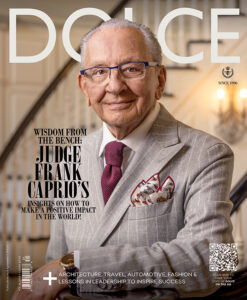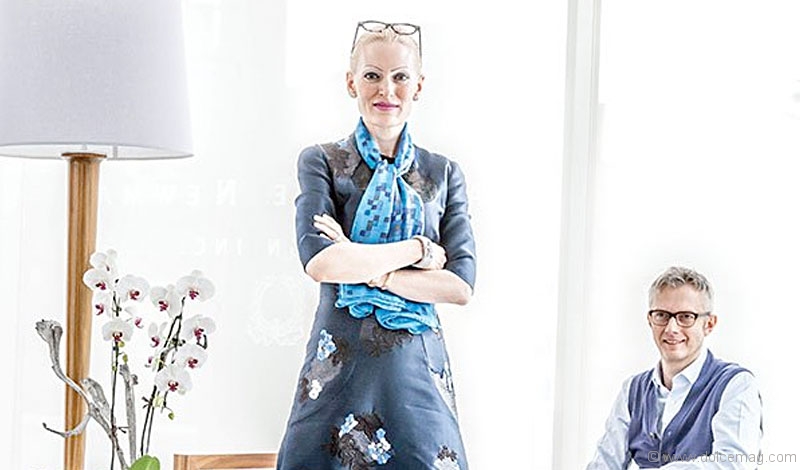Katherine Newman-Design Menagerie
There’s circumstance, there’s cohesiveness and there’s a whimsical wonderment that gambols somewhere between the two. On a tree-lined street in a residential North York area, a restored French colonial revival home, originally built in the 1930s, reveals gracious Georgian farmhouse vernacular with a steeply pitched roof and dormers, paired chimneys and Credit Valley stone. Inside, a strong horizontal axis running through the width of the house takes visitors to a French ’40s-inspired library elevated in its own space, all the way through to the west end of the home to where a kitchen and breezeway await. Along the way jolts of juxtaposition unfold in the form of fresh modern twists and contemporary callings: pops of mauve and chocolate and bamboo; gold cowhide and Macassar ebony; Chinoiserie pagoda pendants and strokes of abstract expressionism.
Behind the eclectic esthetic of this fanciful country home stands the equally eclectic interior designer Katherine Newman, who, along with her partner, architect Peter Cebulak, has galvanized ground-up residential properties across Canada and the U.S. with attention to detail and the ability to project the interplay between light and dark, old and new, history and design. From the exterior envelope of a home to the sweeping, detailed contents inside, the twosome sketch, conceptualize and furnish their way to quality architecture and complementary custom interiors that have caught the attention of homeowners who value affordable luxury, domestic esthetics and the comprehensive process that Newman’s eponymous firm applies to the five projects it takes on per year.
It’s half-past noon at the Katherine Newman Design office on Davenport Road in Toronto, and the inner workings of a mind fixated on design perpetuate with every step taken toward the heart of the studio. Newman, who arrives in zany purple tights and an elbow-sleeve Erdem dress pressed with an appliqué floral motif, quickly becomes the focal point of a space furnished in cast copper tables, a white oak recamier and glass console below a menagerie of mirrors. Behind her a bookshelf, lined with fat volumes of New York design in the 1900s, texts that explore postwar and contemporary art, French architecture and the contemporary clean lines of the Bauhaus school of design.
Effortlessly gliding across the room in Azzedine Alaïa lace-up platform booties with insanely sky-high heels, her choice of footwear speaks to the edge she craves and the heights she’s scaled for the sake of design. But a bashful Newman, who prefers her work to speak for itself as she stands on the sidelines, tentatively looks around and crosses her arms as though to shield herself from the lights and cameras set up to capture her. Her throaty laughter nervously rings through the air. “I’m like Woody Allen — I like to live in a bubble and do my work.”
Leading the way to a boardroom panelled in pine and hand-carved by European artists, Newman takes a seat on a white Dally bench by Lona Design, the designer furniture company she and Cebulak founded in the year 2000. A world-travelled Newman, with black-rimmed eyeglasses perched on the crown of her head, sounds the story of how, by way of osmosis and early exposure to impactful decorators, her work came to be. “My mother was a designer,” explains Newman, “[so] there was always a very strong focus on interiors. We used to travel, and I remember staying at the Royal Hawaiian Hotel in Hawaii for six weeks every year. It was designed by Dorothy Draper, an American icon, and one of the first decorators so to speak. I remember banana leaf wall covering and my mother rearranging furniture the night we arrived at the hotel, so [design] was really embedded [in me.]” While she ended up at law school to please her father, she soon realized that her calling in life was to instead raise the bar in design. “I guess I was my mother’s assistant for years,” she smiles.
While the bright colours and prints famously used by Draper were the backdrop to a childhood adorned in anti-minimalist design, it was the groundbreaking work of designer Frances Adler Elkins and her support of artists such as Jean-Michel Frank and Alberto Giacometti that caught the inquisitive nature of Newman. An eminent designer of the 20th century, Elkins became famous for her aplomb and eclectic, bold palettes, transforming residential and commercial properties across California to the applause of her blue-chip and celebrity clients. The sister of famed country house architect David Adler, Elkins and her brother often travelled to Europe on furniture-buying trips, and collaborated on the design of many houses — some of which are still studied by architectural historians today. “In terms of a model, I sort of look at that and say, that’s sort of Peter and me in a funny way,” says Newman, adding that the 1940s method of design is one she admires most. “The approach was not completely rejecting the past but taking historical references, pairing them down, less about ornamentation and more about a combination of materials in a more refined, geometric, linear way. I would say not rejecting the past, understanding that there’s a relevance, but it can be reinterpreted, is definitely who we are.”
With an eye on the past and a nod to everyday modernism, the last 23 years has seen Katherine Newman Design raise and nurture projects from conception to inception, maturing into a full-service interior and architectural design/build firm catering to the restoration and design of family residences at home and abroad. “Historically, design was approached that way,” explains Newman, “and we just believe that there is no other way to create a cohesive esthetic where all elements — exterior, interior, landscaping, contents — have continuity in terms of language and relevance.”
While Newman describes the esthetic differences between Cebulak and herself as a “good tennis game,” their integration of unorthodox and diverse architectural styles and furnishings has become a touchstone in their work. “It’s a funny collaboration, not like one you see in the movies and we’re sitting in a boardroom and sketching together. It happens everywhere. It happens while we’re driving the car … It’s just our life,” says Cebulak. A self-described former pupil of black-and-white architecture, Cebulak explains that he was able to step outside his “pre-conditioned” approach to design after Newman coloured his world with her outside-the-box ideas.
Recent projects, which include a shingle-style home in New Jersey, an 8,000-square-foot apartment in Manhattan and a sprawling ranch situated in the wilderness of British Columbia, exemplify the variation of projects they take on and the lengths they go to rear distinct and unique projects that speak in the language of the homeowners.
In the case of the five-bedroom family country home described above, a focus on architectural detailing and an emphasis on continuity weave their way through the historical domicile. The challenge, report Newman and Cebulak, was to uplift the bones of an existing structure 10 minutes away from Toronto and create an eclectic, whimsical voice that spoke to the nuances of both urban and rural living. Completed in 2010 after several additions and renovations, the private southern Ontario couple who purchased the house were handed the keys to an enchanting retreat just minutes away from the bright lights of the city. Dipping back into the past when, as a little girl, her interest in houses and people and how they lived first developed, Newman explains that the primary focus for Cebulak and her is what the home ultimately means to its occupants. “No matter where our clients travel, no matter where they go, no matter what they are exposed to, [we hope] that they have that still relief when they return after a holiday, and they go back to the house and say, ‘Wow, nothing beats this.’”




























































































No Comment